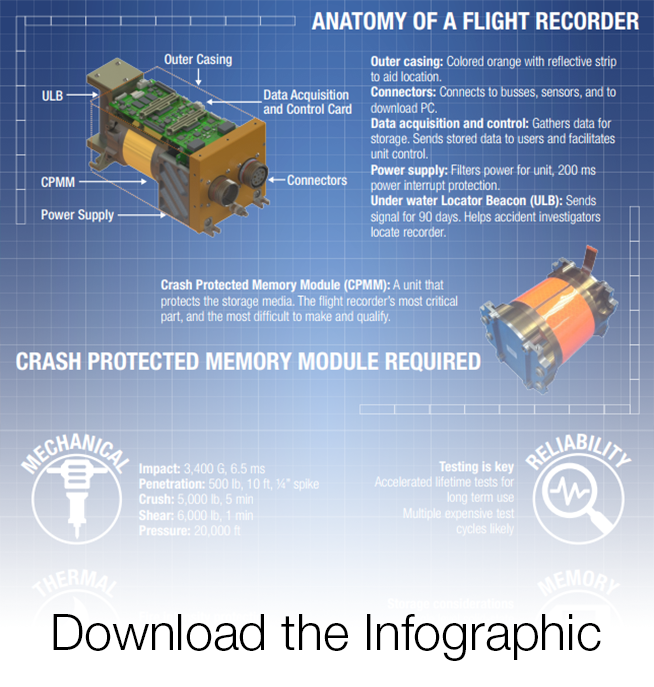
Designing a flight recorder that complies to international standards and crash survivability is very challenging and is usually far more expensive than buying one from an established flight recorder manufacturer. Nevertheless, many organizations wish to develop their own flight recorders to develop the technology in-country, reduce costs, and/or to be able to create highly customized recorders for particular applications. But to do so, it is important to be aware of the essential components of a flight recorder and what it takes to develop one.

Generally, a flight recorder can be split into several parts: an outer casing, connector, Underwater Locator Beacon (ULB), power supply, data acquisition and control circuitry, and storage. What sets an flight recorder apart from any other recorder is the need for it to protect the data stored within the crash protected memory module in the event of an incident. This crash protected memory module is the most difficult part to manufacture, as it needs to protect the memory from damage from impacts, fire, water, and other hazards. There are only a small number of flight recorder manufacturers, and their crash protected memory modules tend to be customized to a particular flight recorder architecture, processor, and application.
The main challenges and considerations when developing a crash-protected flight recorder memory module are mechanical and thermal protection, memory, and reliability and testing.
Mechanical Protection
The case must be designed to withstand impact, crushing, and penetrative forces. What’s more, the shape of the case must adhere to standards set by ED-112A to ensure proper testing is conducted and that the Underwater Locator Beacon can be securely attached. The two most popular choices for case material are titanium and stainless steel, the first having a better strength to weight ratio, and the second being less expensive.
Thermal Protection
Safeguarding your module against high temperatures is critical, as it may very well damage the solid-state memory. An issue with selecting a suitable material to use for thermal protection is that most materials are patented, meaning designers are either restricted to a limited range of non-patented materials or are required to pay a licensing fee. Many substances that can be used freely require large volumes, increasing the weight and size of the recorder. By contrast, if you are looking to develop your own crash box, then you may need to develop your own thermal protection substance, which may require a significant investment of time and money.
Memory
Memory is at the core of a crash protected memory module. Old recorders may use magnetic tape, but flash memory is more common nowadays. However, modern memory devices are not developed with flight data recorders in mind as they make up a very small share of the market. While new dense memory modules are great for affordable large capacities for phones, computer drives, and so forth, they tend to be more error prone at high temperatures. Hence, it is key to select and validate a suitable memory device for the solution.
Reliability and Testing
After designing and developing your crash survivable box, you need to not only ensure it will pass the crash survivability tests, but that it is also reliable for a long period of time in an aerospace environment, resisting wear and tear, high temperatures, vibration, and shocks. Tests can be expensive and are executed many times before a product is approved. This is perhaps the core reason it takes a long time to develop a crash protected memory module. If a failure happens, as they mostly do in development, you must go through the whole expensive process again.
There are commercial reasons to develop flight recorders using a crash protected memory module from another manufacturer. To meet the highest standards and maintain your flight recorder project within budget, it might be reasonable to buy one or certain modules as opposed to developing one from scratch. If you are interested in getting the full scope of the difficulties and particularities of designing an flight recorder, read our white paper, “Why is it so Difficult to Design a Flight Recorder?”.